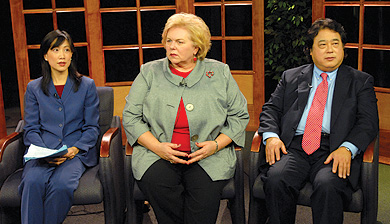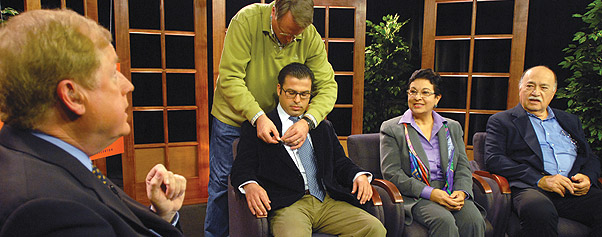First 'OC Insight' Episode Focus on Immigration and Wage Issues
April 1, 2008
by Valerie Orleans
photos by Kelly Lacefield
When the first two “OC Insight” episodes air, viewers will see discussions on illegal immigration and wage issues. Here is a glimpse of the program highlights.
Immigration Issues
The first “OC Insight” tackles immigration. A panel of experts — Erualdo R. González, assistant professor of Chicana and Chicano studies; Lilia Tanakeyowma, dean of student affairs at Santa Ana College; and Amin David, community activist and president of Los Amigos of Orange County — met with moderator Roger Cooper to discuss why some people are alarmed at the number of immigrants settling in Orange County.
“The whole immigration debate is disquieting,” David said. “For many years, this country has extended a quasi invitation to those living south of the border to come and work here. Suddenly, when we’re faced with a declining economy, everyone wants to blame immigrants. We need a reality check.”
Tanakeyowma added, “This is a historical reaction. Whenever we are facing deficits and budget cuts, we blame the immigrant population. We definitely see that in central Orange County, where we have a high number of immigrants.”
For example, there are radio shows that argue that undocumented immigrants drain resources from the communities where they reside.
“That assumption is incorrect,” David said. “Immigrants contribute to society and their communities. They pay rent and taxes. They put currency into circulation. Those who make these arguments prey on the weaker members of our community — those who are most vulnerable.
“We need to approach this in a reasonable way,” David added. “If immigrants have been in this country for many years, have been working here and have children in school, we need to start a process to document them.”
Added Tanakeyowma: “I’d also like to see some differentiation among undocumented immigrants — between those who have come here to work and those who are committing crimes. The vast majority of immigrants are simply seeking a better life for their families.”
She said she often sees students who don’t even realize they are undocumented until they try to apply for college admission.
“They want to become doctors and lawyers, but they don’t have documentation,” she added. “Limiting their access to financial aid for college in the country where they’ve lived for most of their lives I don’t believe is fair. I would like to see these outstanding students be able to obtain a college degree, become citizens and work to make our communities productive.”
González advocates merging such ideas with public policy.
“I understand people’s concerns about losing what they believe are American standards,” he said. “But this country has always been changing and adapting. We need to be the agents of social change and work with immigrants to make our communities stronger.”
Waging a Living
Three experts — Davina Ling, assistant professor of economics and the director of the International Center for the Economics of Pharmaceuticals, Aging and Health on campus; Lucetta “Lucy” Dunn, president and chief executive officer of the Orange County Business Council; and Alan Woo, director of planning and program development for the Community Action Partnership of Orange County — addressed the problems facing low-wage earners in Orange County in the second episode of “OC Insight.”

From left: Davina Ling, Lucetta “Lucy” Dunn and Alan Woo.
Orange County ranks second in the nation when it comes to high housing prices. Today, the average home price in the county is more than $700,000. For low-wage earners, the high cost of living, especially housing, can easily push them into poverty.
“Many people who work full time can’t make a living here,” Dunn said. “To afford a one-bedroom apartment in Orange County, you need to make at least $26 an hour. Our housing costs keep many out.”
In addition to the housing crunch, Woo said the lack of affordable child care is a big problem for working mothers, particularly if they are single.
“We have about 800,000 clients at the Partnership,” he said. “Most of them are working one or two jobs but they still can’t afford the high living cost here. They’re working very hard to stay poor.”
Lack of health insurance is another barrier for the poor.
“Many work for companies that don’t offer benefits, or they’re self-employed and can’t afford the costs,” Ling said. “This includes middle-class families as well as the poor. One serious health problem can easily bankrupt a family.”
Solving the problems facing the working poor requires all cities to provide affordable housing and services to their residents, Woo said. “Some cities are doing a great job, but many more need to get on board.”
According to Dunn, Orange County’s CEOs rank the high cost of housing as their greatest concern.
“There now are more people commuting from Los Angeles into Orange County than vice versa,” she said, noting that the county has lost 13 percent of 25- to 34-year-old workers over the last five years, according to the Orange County Business Council.
“Some of these younger people will move to areas immediately outside of Orange County, but others will move to Arizona or Colorado or other states,” Dunn said. “They simply can’t afford to live here, and we’ll see a brain drain. As our population ages, there will be fewer young people here to take on new jobs.”
What Orange County needs to focus on, according to the panel, is supporting the efforts of those who seek self-sufficiency, increasing the availability of affordable housing, ensuring that adequate roads and highways are available to move people and goods efficiently and providing the educational opportunities to help students achieve their career goals, particularly in the fields of science, technology, engineering and math.


